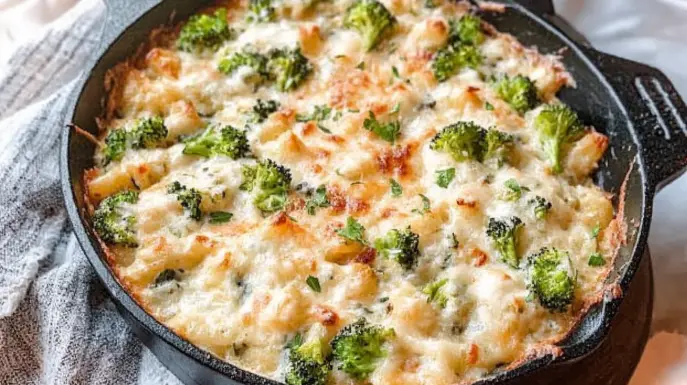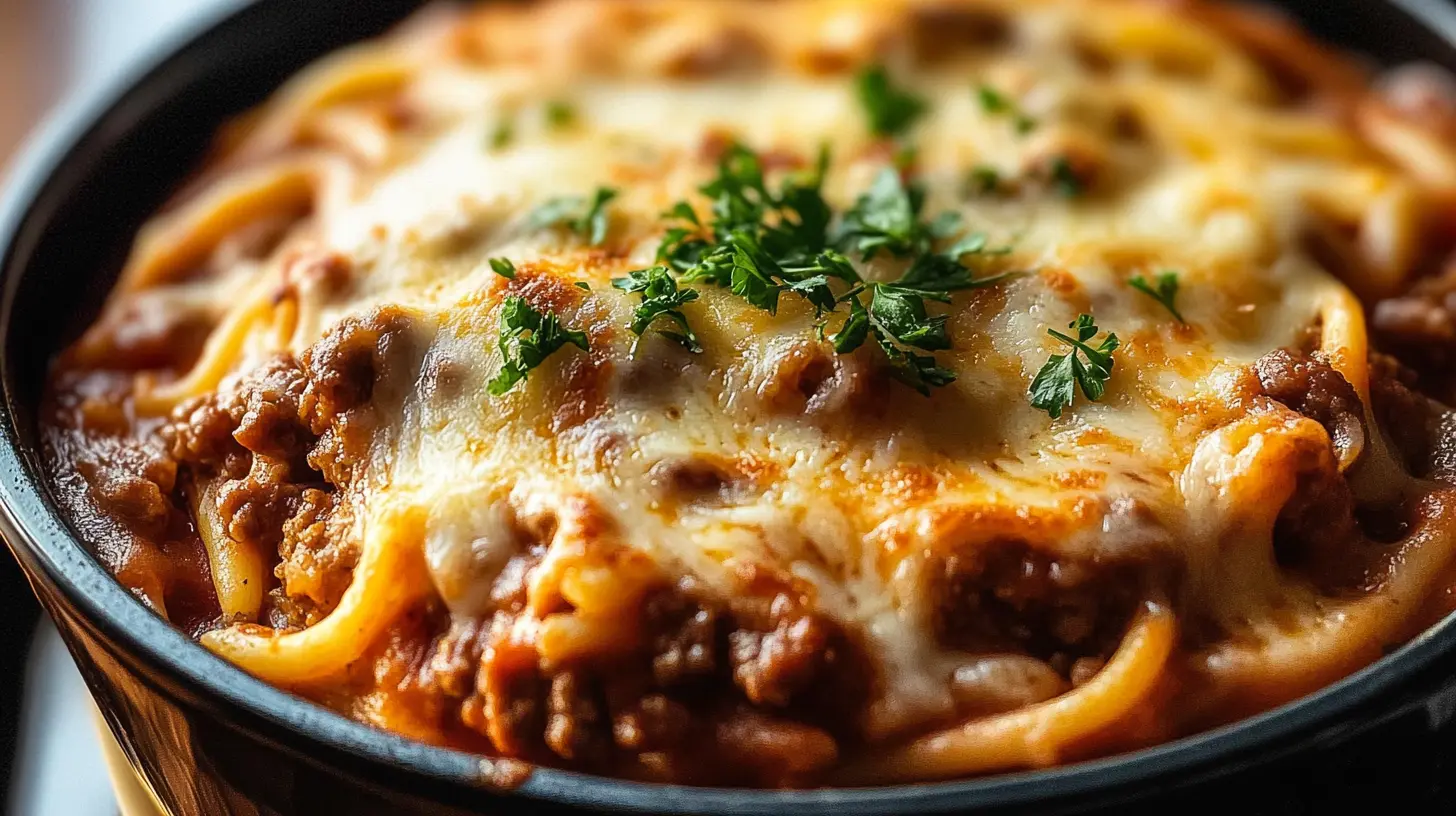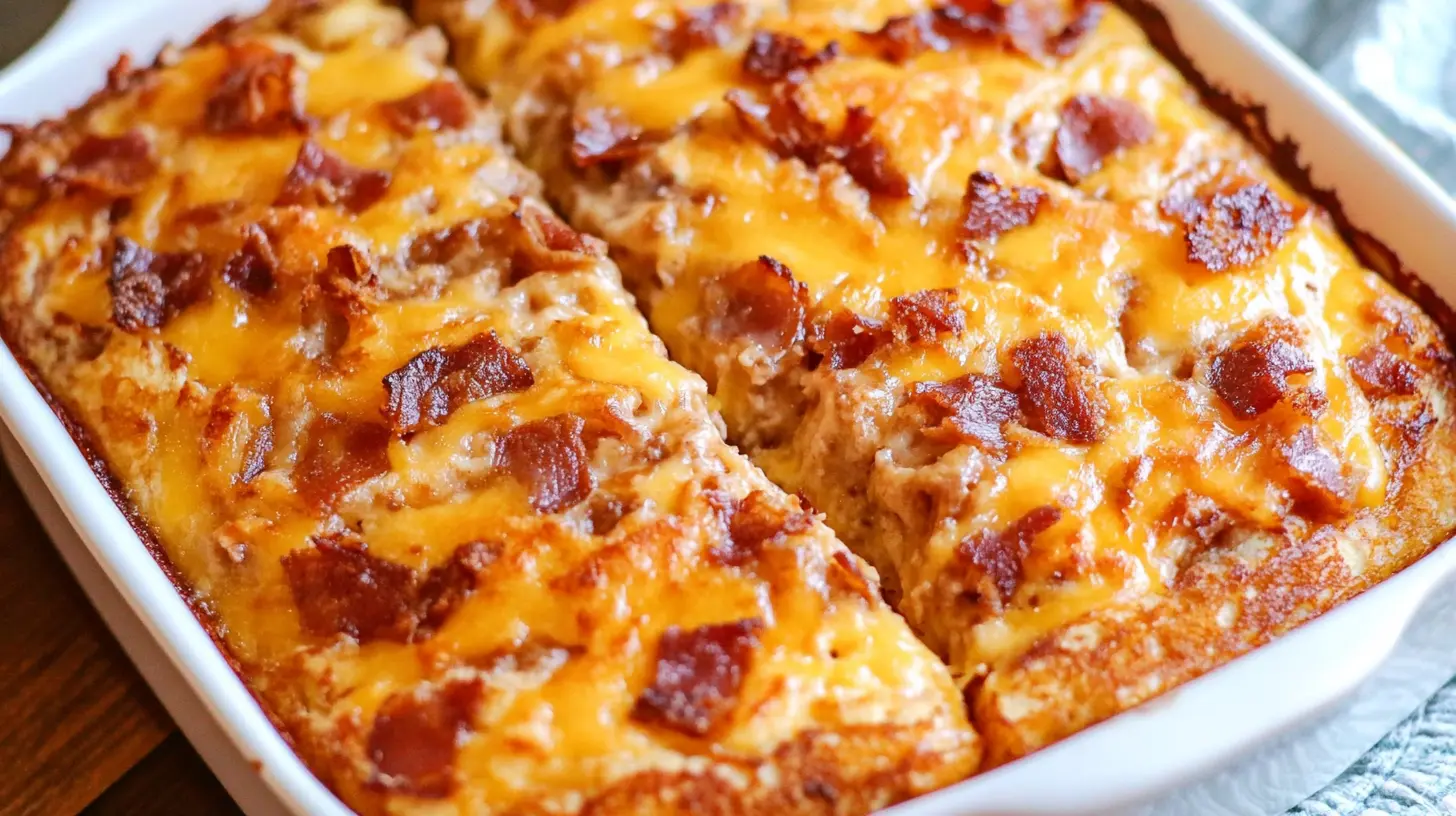Introduction to Keto Casserole
Looking for a hearty and delicious meal that fits your low-carb or keto lifestyle? Keto Casserole is the perfect solution! This dish is packed with nutritious ingredients like protein-rich chicken, healthy fats from cheese and cream, and flavorful vegetables, making it both satisfying and filling. Whether you’re following a keto diet or just looking to cut carbs, this casserole offers all the flavor without the excess carbohydrates.
For more keto meal ideas, check out our popular Easy Keto Diet Shrimp for another low-carb recipe that’s sure to impress!
Benefits and Advantages of Keto Casserole
1. Low-Carb and Keto-Friendly
Keto casseroles are specifically designed for low-carb diets, meaning they’re high in healthy fats and low in carbohydrates. This makes them an excellent choice for those following a keto diet, helping you stay in ketosis while still enjoying a comforting and flavorful dish.
2. Quick and Easy to Prepare
This casserole takes only about 30 minutes of prep time, and then you can pop it in the oven and let it bake. It’s a convenient meal option for busy parents, students, and working professionals who need something easy yet healthy for dinner.
3. Highly Customizable
One of the great things about keto casseroles is that you can adjust the ingredients to suit your tastes and dietary needs. If you prefer a different protein, like beef or pork, or if you’d like to add more vegetables, the casserole can easily be modified to your liking.
For another comforting and healthy meal, try our Smoked Hamburger Casserole—perfect for those on low-carb diets!
Ingredients Overview of Keto Casserole
Essential Ingredients for Keto Casserole
- 2 cups shredded cooked chicken (or substitute with beef or pork)
- 1 cup broccoli florets (or other low-carb vegetables like cauliflower or zucchini)
- 1 cup shredded cheddar cheese
- 1 cup heavy cream
- 4 oz cream cheese (softened)
- 2 tbsp olive oil (or butter)
- 1 tsp garlic powder
- 1 tsp onion powder
- Salt and pepper to taste
- Fresh parsley (for garnish)
Dietary Substitutions to Customize Your Keto Casserole
Dairy-Free Option:
If you’re following a dairy-free keto diet, substitute the cheddar cheese with dairy-free cheese and use coconut cream instead of heavy cream. There are many plant-based alternatives available that work just as well without compromising the flavor or texture.
Vegetarian Option:
For a vegetarian version, omit the chicken and use a combination of low-carb vegetables like zucchini, cauliflower, and mushrooms. Add more cheese or a plant-based protein like tofu or tempeh to keep the dish filling.
High-Protein Option:
If you want to increase the protein content of your keto casserole, you can add extra shredded chicken or swap in ground beef. Additionally, using more cheese or incorporating eggs will boost the protein levels while keeping it low in carbs.
How to Prepare the Perfect Keto Casserole: Step-by-Step Guide
First Step: Preheat the Oven
Preheat your oven to 375°F (190°C). Grease a 9×13-inch casserole dish with olive oil or butter to ensure the casserole doesn’t stick.
Second Step: Prepare the Vegetables
In a skillet, heat 1 tablespoon of olive oil over medium heat. Add the broccoli (or any other vegetables you’re using) and sauté for about 5 minutes, until they are slightly softened but still have a bit of crunch.
Third Step: Make the Creamy Base
In a large mixing bowl, combine the heavy cream, softened cream cheese, shredded cheddar, garlic powder, onion powder, salt, and pepper. Stir until the mixture is smooth and well combined. If the mixture is too thick, you can add a little more cream to loosen it up.
Fourth Step: Assemble the Casserole
Place the shredded chicken in the prepared casserole dish, and spread the sautéed broccoli on top. Pour the creamy mixture over the chicken and broccoli, making sure it covers everything evenly.
Fifth Step: Bake the Casserole
Place the casserole in the preheated oven and bake for 25-30 minutes, or until the cheese is melted and bubbly. The top should be golden and crispy.
Sixth Step: Garnish and Serve
Once baked, remove the casserole from the oven and let it cool for a few minutes. Garnish with freshly chopped parsley before serving.
For another easy-to-follow recipe, check out our Chicken Quesadilla Recipe, which is great for busy weeknights.
Mastering Keto Casserole: Advanced Tips and Variations
1. Add Extra Vegetables
To increase the fiber and nutrient content, add more low-carb vegetables like spinach, kale, or bell peppers. These will not only add color but also provide extra vitamins and minerals to the dish.
2. Make It Spicy
If you like a little heat, consider adding chopped jalapeños or a dash of hot sauce to the cream mixture. You can also use spicy cheddar cheese for an extra kick.
3. Add Toppings
For an even crispier top layer, sprinkle some Parmesan cheese or crushed pork rinds over the casserole before baking. This adds a crunchy texture that complements the creaminess of the dish.
How to Store Keto Casserole: Best Practices
Refrigeration:
To properly store any leftover casserole, make sure to place it in an airtight container to prevent moisture loss and protect it from absorbing other odors in the fridge. The casserole can safely be stored in the refrigerator for up to 3-4 days. This time frame ensures that the dish remains fresh without compromising its flavor or texture.
Freezing:
Freezing keto casseroles works exceptionally well, making them a convenient option for meal prep. To freeze the casserole before baking, tightly wrap it with plastic wrap, ensuring you expel all air, and then cover it with aluminum foil for added protection against freezer burn. This method locks in freshness and prevents ice crystals from forming. You can also choose to freeze the casserole after baking. In both cases, label the casserole with the date to track how long it’s been stored. When you’re ready to use it, transfer the casserole to the refrigerator to thaw overnight for even defrosting. After thawing, follow the reheating or baking instructions to enjoy the casserole with no loss in flavor or texture.
Reheating:
When you’re ready to reheat your keto casserole, the oven is the best option, especially if you want to keep the top crispy. Set your oven to 300°F and place the casserole on the middle rack, uncovered. This method ensures the casserole warms evenly and retains its texture, which can sometimes become soggy in the microwave. Heat the casserole for about 15-20 minutes, or until it’s thoroughly warmed. If you notice the top browning too quickly, you can loosely cover it with foil halfway through the reheating process. For smaller portions, you can use the microwave for quicker results, but the oven will give you the best taste and texture, especially for dishes with crunchy toppings.
Nutritional Value of Keto Casserole
Here’s an approximate nutritional breakdown per serving (based on 8 servings):
- Calories: 350
- Fat: 28g
- Carbohydrates: 5g
- Protein: 20g
- Fiber: 2g
This keto casserole provides a great balance of healthy fats and protein, keeping the carbs to a minimum. It’s perfect for those on a ketogenic diet looking for a filling and satisfying meal.
FAQs: Frequently Asked Questions About Keto Casserole
1. What is extremely lazy keto?
Extremely lazy keto is a simplified version of the ketogenic diet where you don’t count macros or calories but primarily focus on keeping your carbohydrate intake very low (usually under 20 grams per day). Unlike traditional keto, which emphasizes tracking your macronutrient intake (fats, proteins, and carbs), extremely lazy keto is more relaxed and flexible. You still eat keto-friendly foods, such as meat, cheese, eggs, and non-starchy vegetables, without worrying about the exact amounts of fat or protein. As a result, this approach is popular among those who want to reap the benefits of ketosis without the hassle of tracking everything.
2. Is garlic OK on keto?
Yes, garlic is allowed on keto, but in moderation. Garlic is a highly flavorful ingredient that can enhance many dishes, and while it does contain some carbohydrates, the amount used in cooking is usually very small. Therefore, it doesn’t significantly affect your daily carb count. One clove of garlic contains about 1 gram of carbohydrates, so it’s unlikely to knock you out of ketosis if used in reasonable amounts. Additionally, garlic provides health benefits such as boosting immunity, making it a great ingredient to keep in your keto-friendly kitchen.
3. Can you eat ground beef on keto?
Yes, ground beef is a great option on the keto diet. It’s high in fat and protein, with zero carbs, making it a staple in many keto-friendly meals. You can use ground beef in various dishes, such as keto casseroles, meatballs, burgers (without the bun), and chili. However, just be mindful of added ingredients like sauces or seasonings that may contain hidden carbs.
4. How many carbs are in chicken and broccoli casserole?
The carb content in a chicken and broccoli casserole depends on the recipe, particularly the sauces and any additional ingredients like cheese, cream, or breadcrumbs. A typical keto-friendly chicken and broccoli casserole made with heavy cream, cheese, and a small amount of broccoli usually contains about 6-8 grams of net carbs per serving. The low-carb content mainly comes from the broccoli, as chicken and fats like cheese and cream contain little to no carbs.
5. What is dirty Keto Casserole?
Dirty keto refers to a version of the ketogenic diet where you still focus on limiting carbs, but the food choices are less healthy. Instead of eating whole, nutrient-dense foods like meats, vegetables, and healthy fats, those following dirty keto may consume processed and junk foods, as long as they stay within the carb limit. However, while dirty keto can help you stay in ketosis and potentially lose weight, it’s not considered the healthiest approach because it can lack essential nutrients and may have long-term health consequences due to poor food choices.
6. Why do I feel so awful on keto?
The reason you may feel awful, especially in the first few days of starting the keto diet, is because your body is transitioning from burning glucose (sugar) for energy to burning fat. This transition can cause a temporary condition known as the keto flu. Symptoms include headaches, fatigue, nausea, irritability, and difficulty concentrating. The keto flu happens as your body depletes its glycogen stores and adjusts to producing ketones for fuel. To alleviate symptoms, stay hydrated, increase your intake of electrolytes (like sodium, potassium, and magnesium), and gradually ease into the diet.
7. Are tomatoes okay for keto?
Yes, you can include tomatoes in a keto diet, but moderation is important. While they are technically a fruit, tomatoes contain fewer carbs compared to most other fruits, with around 4 grams of carbs per 100 grams. Because of their lower carb content, you can easily incorporate them into keto meals like salads, sauces, and casseroles. However, you should be mindful of tomato-based sauces or canned tomatoes, as these products often have added sugars that can significantly increase the carb count. Therefore, always check labels to ensure you’re staying within your carb limits.k labels to ensure you’re staying within your carb limits.
8. Is cucumber keto?
Yes, cucumbers are an excellent choice for a keto diet. They are low in carbohydrates, with only about 3.6 grams of carbs per 100 grams, making them a refreshing and hydrating option. Cucumbers are often used in salads, dips (like keto-friendly tzatziki), or as a crunchy snack when paired with high-fat dressings or cheese.
9. Why avoid onions on keto?
Onions are typically avoided or limited on keto because they are higher in carbohydrates compared to other vegetables. A medium onion contains about 11-12 grams of carbs, with around 9 grams of net carbs, making it relatively carb-dense for keto. While onions are often used for flavor, consuming large amounts can quickly add up in terms of carbs. This is why many keto dieters choose to use onion powder or green onions (scallions), which are lower in carbs and provide a similar flavor profile.
Conclusion
The keto diet is a flexible approach to healthy eating that can be tailored to suit various preferences and needs. From using garlic in moderation to including keto-friendly ingredients like ground beef, cucumbers, and tomatoes, this diet offers plenty of delicious, low-carb options. Whether you’re curious about extremely lazy keto or experiencing discomfort during the transition phase, understanding the basics of keto and its food choices can help you succeed in reaching your health goals. As with any diet, balance and nutrition should remain a priority, even when indulging in keto-friendly comfort foods.
For more detailed information on the ketogenic diet and its variations, visit the Wikipedia page on the ketogenic diet.
For more dairy-free and keto-friendly ideas, check out our Vegan Gluten-Free Recipes for inspiration!
PrintKeto Casserole Recipe: Delicious Low-Carb Comfort Food
Walking taco casserole is a fun and flavorful dish that transforms the classic walking taco into a hearty baked meal. Perfect for busy weeknights, potlucks, and family gatherings, this dish is simple to prepare and customizable to various dietary preferences.
- Total Time: 35 minutes
- Yield: 6 servings 1x
Ingredients
- 1 lb ground beef or turkey (or plant-based crumbles for a vegan option)
- 1 packet taco seasoning (or homemade blend)
- 1 can (15 oz) black beans, drained and rinsed
- 1 can (10 oz) diced tomatoes with green chilies (or fresh equivalent)
- 2 cups shredded cheese (cheddar, Mexican blend, or dairy-free alternative)
- 1 bag tortilla chips (regular, baked, or gluten-free)
- Optional toppings: sour cream, salsa, shredded lettuce, jalapeños
Instructions
Step 1: Preheat Your Oven
Preheat your oven to 350°F (175°C) to ensure it’s ready for baking.
Step 2: Cook the Meat
- In a large skillet over medium heat, cook the ground beef or turkey until browned.
- Drain any excess grease, then stir in the taco seasoning with 1/3 cup water. Let it simmer for a few minutes.
Step 3: Layer the Casserole
- In a greased 9×13-inch baking dish, spread a layer of crushed tortilla chips.
- Add the seasoned meat, followed by a layer of black beans and diced tomatoes with chilies.
- Top with shredded cheese.
Step 4: Bake
- Bake for 20-25 minutes or until the cheese is melted and bubbly.
- For a crispy top, broil for an additional 2-3 minutes, watching closely.
Step 5: Serve and Enjoy
- Let the casserole cool for a few minutes before serving.
- Add your favorite toppings such as sour cream, salsa, shredded lettuce, or jalapeños.
Notes
Customization Options
- Vegan: Use plant-based crumbles, vegan cheese, and dairy-free sour cream.
- Gluten-Free: Opt for certified gluten-free tortilla chips and taco seasoning.
- Lower-Calorie: Use baked tortilla chips, lean ground turkey, and low-fat cheese.
Storage
- Refrigeration: Store leftovers in an airtight container for up to 3 days.
- Freezing: Wrap tightly and freeze for up to 3 months. Thaw overnight before reheating at 350°F (175°C) for 10 minutes.
- Prep Time: 10 minutes
- Cook Time: 25 minutes
- Category: Dinner
- Method: Baking
- Cuisine: Mexican-American
- Diet: Vegan
Nutrition
- Calories: ~450 kcal
- Sodium: ~900mg
- Fat: ~20g
- Carbohydrates: ~40g
- Fiber: ~5g
- Protein: ~25g




